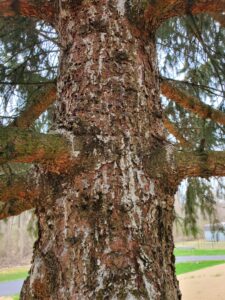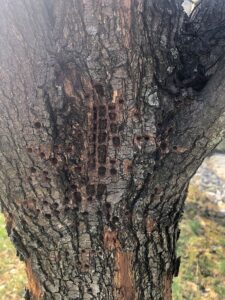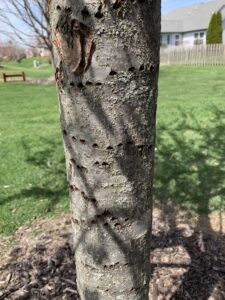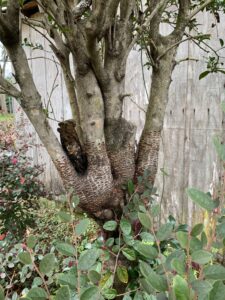When we see round holes in the bark of a tree we often think the cause might be due to wood boring insects or bark beetles. However, that is not always the case. Small holes arranged in neat, uniform rows and columns on the trunks of trees or woody shrubs are usually caused by sapsuckers, a type of wood pecker, instead of insects. Sapsuckers (Sphyrapicus spp.), as the name implies, feed on the sap of living trees by drilling a row of shallow holes in the bark to genera “sap wells” that fill with sap and attract insects. While sapsuckers feed on the insects that get trapped, they feed primarily on the sap that is exuded by the tree. They often have preferred host species and you will often find them returning to the same tree that they have already drilled holes from a previous season to increase their size and generate fresh sap. Overtime, as the number and size of holes increase, the damage caused can lead to girdling of branch limbs or even the trunk of the tree. Thinner barked trees, like birch and maple, may be more susceptible to girdling and dieback due to sapsucker damage. Typically, if the damage is limited and minor, the tree will recover and vigor is not significantly affected, but repeat injury to a specific location on a given tree can predispose the tree to infestation by insects or infection by decay fungi.
- Fig. 1: Spruce sample with symptoms of sapsucker damage and extensive resin flow.
- Fig 2: Sapsucker injury on trunk of a Callery pear tree. This invasive species would be a good candidate tree to sacrifice to the sapsuckers.
- Fig 3: Sapsucker injury on trunk of a crabapple tree.
- Figure 4. Sapsucker injury on Sasanqua.
Since woodpeckers are classified as migratory, non-game birds and are protected by the Federal Migratory Bird Treaty Act, it is illegal to kill wood-peckers (i.e., sapsuckers) without a permit issued by the Law Enforcement Division of the US Fish and Wildlife Service. Management recommendations are typically designed to inconvenience or scare the birds from trees, including using sticky repellants, mylar flashing tape, aluminum foil strips, and predatory bird-mimics. Use of a barrier, like plastic netting, hardware cloth or burlap, around injured areas can help discourage further feeding in that location, but sapsuckers may simply move to another part of the tree or to trees in the nearby area. That being said, if trees are already severely damaged and a sapsucker is happy coming back to that one tree and few others, it might best to let them have it as a bribe to not attack your other trees.



